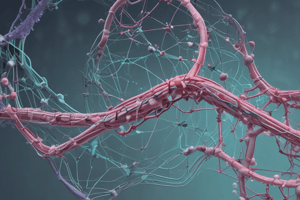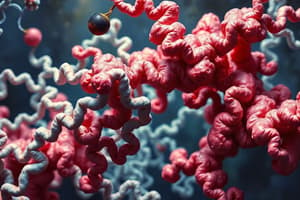Podcast
Questions and Answers
What characterizes the primary structure of a protein, and why is it significant?
What characterizes the primary structure of a protein, and why is it significant?
The primary structure is defined by the linear sequence of amino acid residues linked by peptide bonds, which is significant because it determines the secondary and tertiary structures essential for protein function.
Describe the two main types of secondary protein structures and the forces that stabilize them.
Describe the two main types of secondary protein structures and the forces that stabilize them.
The two main types of secondary structures are the α-helix and the β-pleated sheet, both of which are stabilized by hydrogen bonds between carbonyl oxygen and amino hydrogen of adjacent amino acids.
How does protein folding relate to its function, and what can lead to loss of function?
How does protein folding relate to its function, and what can lead to loss of function?
Protein folding is crucial as it determines the protein's final three-dimensional shape vital for its function, and mutations in the primary structure can lead to improper folding and subsequent loss of function.
What is the role of hydrogen bonds in maintaining secondary protein structures?
What is the role of hydrogen bonds in maintaining secondary protein structures?
Explain the significance of the N-terminal and C-terminal ends in the primary structure of proteins.
Explain the significance of the N-terminal and C-terminal ends in the primary structure of proteins.
Define tertiary structure in proteins and explain how it is stabilized.
Define tertiary structure in proteins and explain how it is stabilized.
What are protein domains, and why are they significant in protein structure?
What are protein domains, and why are they significant in protein structure?
Describe quaternary structure and its importance in protein functionality, using hemoglobin as an example.
Describe quaternary structure and its importance in protein functionality, using hemoglobin as an example.
Discuss the potential clinical implications of misfolded proteins in human health.
Discuss the potential clinical implications of misfolded proteins in human health.
Explain the differences between secondary, tertiary, and quaternary structures in proteins.
Explain the differences between secondary, tertiary, and quaternary structures in proteins.
Flashcards
Primary Structure of Protein
Primary Structure of Protein
The linear sequence of amino acid residues linked by peptide bonds, ranging from 50 to ~2000 amino acids.
Secondary Structure of Protein
Secondary Structure of Protein
The repeating arrangements of adjacent amino acids in a polypeptide chain, maintained by hydrogen bonds, forming regular structures like alpha-helices and beta-pleated sheets.
α-helix
α-helix
A rigid, spiral structure in protein's secondary structure, where the polypeptide backbone is tightly packed, and side chains extend outward.
β-pleated sheet
β-pleated sheet
Signup and view all the flashcards
Protein folding
Protein folding
Signup and view all the flashcards
Protein denaturation
Protein denaturation
Signup and view all the flashcards
β-Sheet
β-Sheet
Signup and view all the flashcards
Tertiary Structure
Tertiary Structure
Signup and view all the flashcards
Domains
Domains
Signup and view all the flashcards
Quaternary Structure
Quaternary Structure
Signup and view all the flashcards
Protein Folding
Protein Folding
Signup and view all the flashcards
Misfolded Proteins
Misfolded Proteins
Signup and view all the flashcards
Protein Subunits
Protein Subunits
Signup and view all the flashcards
Non-covalent interactions
Non-covalent interactions
Signup and view all the flashcards
Clinical Implications
Clinical Implications
Signup and view all the flashcards
Study Notes
Protein Structure & Modifications
- Learning Objectives (ILOS):
- Describe different protein orders.
- Deduce the importance of protein folding.
- Correlate protein structure to function.
- Classify proteins based on structure & function.
- Interpret denaturation's effect on structure & function.
Orders of Protein Structure
-
Primary Structure: Defined by the linear sequence of amino acid residues linked by peptide bonds.
- Contains between 50 and 2000 amino acids.
- Amino acid composition significantly impacts protein's physical & chemical properties.
- Sequence is read from N-terminus to C-terminus.
- Primary structure determines secondary and tertiary structures, crucial for protein function.
- Abnormal amino acid sequences in genetic diseases can lead to improper folding, loss of function, and potentially diagnosable conditions.
-
Secondary Structure: Regular, recurring arrangements of adjacent amino acid residues.
- Formed by hydrogen bonds.
- Two main types:
- α-helix: Tightly packed, coiled, rigid spiral structure.
- β-sheet: Sheet-like structure formed by hydrogen bonds between aligned polypeptide segments.
-
Tertiary Structure: The three-dimensional, folded, and biologically active conformation of a protein.
- Determined by interactions between side chains of amino acids:
- Ionic interactions, disulfide bonds, hydrogen bonds.
- Reflects the protein's overall shape.
- Determined by interactions between side chains of amino acids:
-
Quaternary Structure: Arrangement of multiple polypeptide chains (subunits).
- Held together primarily by non-covalent interactions (like hydrogen bonds).
- Subunits may function independently or cooperatively.
Protein Domains
- Domains: Three-dimensional structural parts of proteins that can fold, function, and exist independently.
- Each domain has unique characteristics.
- Some proteins contain a single domain, while others may have multiple.
- Domains can have specialized functions, like binding to coenzymes.
Protein Classification
-
Classification Based On Chemical Composition:
- Simple Proteins: Composed solely of amino acids (e.g., albumin, collagen).
- Conjugated Proteins: Contain a non-protein component (e.g., glycoproteins, lipoproteins).
-
Classification Based On Shape:
- Fibrous Proteins: Elongated, strand-like, primarily structural (e.g., keratin, collagen):
- Highly resistant to digestion.
- Provide mechanical support and protection.
- Globular Proteins: Compact, spherical, diverse functions (e.g., enzymes, hormones, antibodies):
- Typically soluble in water.
- Exhibit complex tertiary structures.
- Act as catalysts (enzymes), receptors, or transporters.
- Examples include myoglobin and hemoglobin.
- Fibrous Proteins: Elongated, strand-like, primarily structural (e.g., keratin, collagen):
-
Classification Based On Biological Value:
- High Biological Value (HBV): Contain all essential amino acids (e.g., meat, poultry, fish).
- Low Biological Value (LBV): Deficient in one or more essential amino acids (e.g., plant-based proteins).
Protein Denaturation
-
Denaturation: Loss of secondary and tertiary structures, while the primary structure remains intact.
- Rupture of non-covalent bonds (hydrogen bonds, ionic bonds, etc.).
- Caused by environmental factors (heat, pH extremes, chemicals, radiation).
-
Effects: Loss of biological activity, change in solubility, protein unfolding.
-
Easily digestible denatured protein.
Chaperones
- Chaperones: Proteins that guide other proteins through the folding process.
- Protect proteins from incorrect folding.
- Shield proteins from harmful interactions, especially at elevated temperatures.
- Called heat shock proteins because their production increases under stress.
Studying That Suits You
Use AI to generate personalized quizzes and flashcards to suit your learning preferences.





